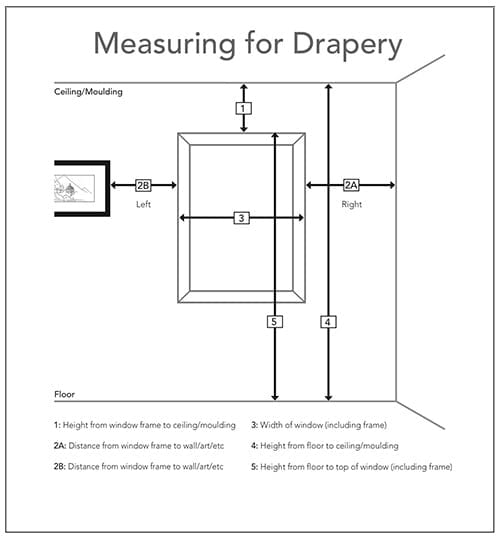Measuring for Drapes
Tips on How to Order Drapes:
In this guide, we want to walk you through step by step on how to order the right drapes for your space.
Measuring:
Measuring for drapes is simple. You want to measure the window itself (width and height), and the wall space all around it. It’s best to measure in inches. Here is great example:

Don’t forget to consider any molding as part of your measurement, whether its on the ceiling or part of the window frame. Include the frame as part of the width and height of the window, but do not include the ceiling molding as part of your height, since you typically don’t install hardware in moldings. Here is an example we are going to work off of:
The window width: 60”
The window height: 60”
Ceiling height (without molding): 96”
Wall Space to the right of the window: 25”
Wall Space to the left of the window: 32”
From the top of the window molding to the ceiling: 16”
From the bottom of the window molding to the floor: 20”
From the top of the window molding the floor:
Calculating the width for stationary panels: Installation typically goes as far out as 6”-12” on each side of the window (given you have the room)and you want to make sure your drapes will look full, which in turn makes them look custom. If you do not have the this wall space, we would recommend installing as close to the wall as possible. You can also use end caps to avoid taking up extra space, which will allow for fuller drapes. So in this case, we would recommend going with a 34”-40” pleated panel. This width is also determined on how much fabric you would like, if less than the 34” option would look perfect. There are very rare cases when we would ever recommend using a 24” pleated drape. This is typically used in a small room with a very small window. In the flat style you can use the 48” or 75” option.
Calculating the width for functional or open/close panels: The installation would remain the same. You would want to take the width of the window, and add the width of where you would be installing. For example: 60” (window width) + 16” (8” on each side), giving you a total width of 76”. This is the area you would need to cover. However, this won’t be your final width. You always want to add extra width to each panel, so when you open the panel, it’s not just a flat piece of fabric, you want volume in the folds. In this case, we would add 6” to each panel. This would bring the total width to 88”, or 44” pleated panels. If you are working with flat panels, the width would be the 48”, and up to 75” option, depending on how much fabric you would like to see.
Calculating your length: For this window, we would typically install 10” above the window. Install would be 90” from the floor. This is where two considerations come into play; the hardware and whether you would like the drapes to hang off the floor, break, and have a puddle. You will need to know the diameter of the rings when calculating the length. For example, we have rings that are 2” in diameter. So if you want your panels to break on the floor, your finished length will 88”. How we got this number:
Take the height of where you are installed and deduct the 2” from the ring diameter. Once they are installed they will drop down whatever the diameter of the rings are. If you would like to have them off the floor, then your panels would be 87” in length. Based on the size puddle you like, anywhere from 1”-3” works great. With a 2” puddle, you would leave your finished length at 90”. Once they are installed, they will drown down the 2” because of the rings. Add or deduct one inch based on your desired puddle.
Of course, this type of scenario is not what you might have in your home, with this type of window, or the wall space around it. This is just a general guide on what to consider and how to measure when ordering drapes. When it comes to tricky spaces that have an eyebrow window, for example, this is where we come in and walk you through on what we would recommend. We love receiving any images you can provide us of the space to guide you in the right direction, and make the prefect pair of panels custom made to your needs.
